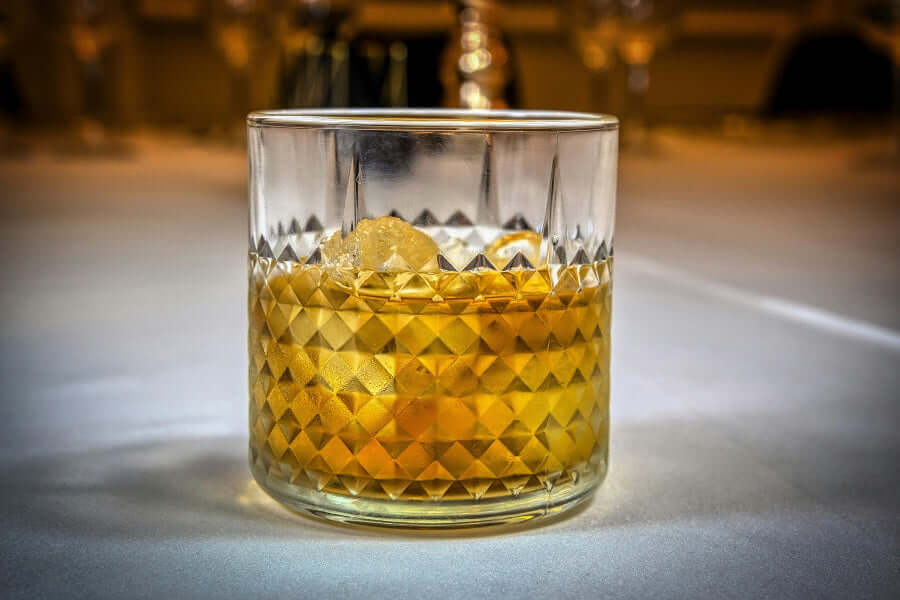An Introduction to Whiskey: Types and Traditions
This guide is designed to be a comprehensive introduction to the world of whiskey, suitable for both experienced enthusiasts and curious newcomers. We'll delve into the history of whiskey, explore the different varieties produced around the globe, and even introduce some fun traditions to enhance your whiskey appreciation.
An Introduction to Whiskey: From Grain to Glass

Whiskey, or whisky (depending on where it's from!), is a distilled alcoholic beverage crafted from fermented grains. The magic all begins with malt production. Barley is the most common grain used, and to unlock its hidden potential, it undergoes a process called malting. The barley is first soaked in water, which allows it to germinate. During germination, enzymes develop within the grain that convert starches into sugars – the perfect fuel for fermentation later on. Once the germination reaches the desired level, the barley is carefully dried, often using peat fires which can impart a smoky flavor to the final product.
After drying, the malted barley is milled into a coarse flour and mixed with hot water. This creates a sweet liquid called "wort," which is then fermented with yeast. The yeast feasts on the sugars in the wort, converting them into alcohol – the foundation of our beloved whiskey.
Following fermentation, the alcohol is separated from the remaining liquid through distillation. This process involves heating the fermented liquid, causing the alcohol (with its lower boiling point) to vaporize first. The vapors are then captured and condensed back into a liquid form, resulting in a high-proof spirit.
But the journey doesn't end there! The newly distilled spirit, often referred to as "white dog" or "new make," is then aged in wooden casks, typically made of charred white oak. This aging process is crucial, as it allows the whiskey to mellow and develop its complex flavors and aromas. The type of wood used, the charring level of the cask, and the duration of aging all play a significant role in shaping the final character of the whiskey.
Whisky Flavors: A Symphony for the Senses
Whiskey boasts a captivating range of flavors that can tantalize your taste buds. Common notes include vanilla, caramel, oak, spice, and fruit. But wait, there's more! Depending on the specific whiskey, you might also encounter hints of smoke, honey, chocolate, or even leather.
These diverse flavors are a result of the intricate interplay between the grain used, the malting process, the fermentation techniques, the distillation methods, and of course, the aging in casks. For instance, heavily peated malts used in some Scotch whiskies can impart a distinct smoky flavor, while ex-bourbon casks used for aging can contribute notes of vanilla and caramel.
How to Taste Whiskey

Now that we've explored the production process and the symphony of flavors, let's delve into the art of whiskey tasting. Here are some tips to elevate your whiskey experience:
- The Glass: Opt for a tulip-shaped glass. It allows you to concentrate the aromas and appreciate the color of the whiskey.
- The Nose: Start by swirling the whiskey gently in the glass. This releases the aromatic compounds, allowing you to identify different scents. Take a few short sniffs and see what notes you can pick up.
- The Sip: Take a small sip and let the whiskey wash over your tongue. Notice the texture, the weight, and the initial burst of flavor. Don't swallow right away! Let the whiskey linger and identify the evolving flavors that develop on your palate.
- The Finish: After swallowing, pay attention to the lingering aftertaste. Does it leave a pleasant warmth or a hint of spice?
Remember, there's no right or wrong way to taste whiskey. Relax, have fun, and explore the unique flavors each whiskey has to offer.
Where Does Our Whiskey Come From?
Whiskey has a rich and diverse history, with different regions around the world developing their own unique styles and traditions. Here are some of the most prominent whiskey-producing regions:
- Scotland: The land of Scotch whisky, renowned for its single malts and blended varieties. Scotch is known for its malty flavor profile, with some regions like Islay being famous for their peaty whiskies.
- Ireland: Irish whiskey is typically triple-distilled, resulting in a smoother, lighter style compared to Scotch.
- United States: The US boasts a wide variety of whiskey styles, including Bourbon (made with at least 51% corn and aged in new charred oak barrels), Rye whiskey (spicy and bold, with rye grain as the primary ingredient), and Tennessee whiskey.
Introduction to Whiskey Types: A World of Exploration
Now that we've familiarized ourselves with the basics of whiskey production and tasting, let's embark on a journey through some of the most popular whiskey types:
1. Scotch Whisky: Hailing from Scotland, Scotch is arguably the most well-known whiskey globally. Here are some key points to remember:
- Grain Bill: Primarily uses malted barley, though some blended varieties may incorporate unmalted grains.
- Aging: Must be aged for a minimum of three years in oak casks to be labeled Scotch.
-
Regions: Scotland boasts five distinct whisky regions, each known for its characteristic style:
- Speyside: Speyside whiskies are known for their light, floral, and honeyed notes.
- Highland: Highland whiskies offer a wider range of flavors, from light and grassy to rich and malty.
- Lowland: Lowland whiskies are typically the lightest and most delicate, often with a grainy or grassy character.
- Islay: Islay whiskies are famous for their distinct peaty flavor, a result of the use of heavily peated malt during production.
- Campbeltown: Campbeltown whiskies are known for their rich, malty character and a hint of saltiness.
-
Types: Scotch comes in two main varieties:
- Single Malt: Made from malted barley produced at a single distillery.
- Blended: A combination of whiskies from different distilleries, often including both malt and grain whiskies. Blended Scotch is known for its consistency and accessibility.
2. Irish Whiskey: Renowned for its smooth and mellow character, Irish whiskey boasts some distinct characteristics:
- Grain Bill: Primarily uses malted and unmalted barley.
- Distillation: Typically triple-distilled, resulting in a lighter and smoother spirit compared to many Scotch whiskies.
- Aging: There's no minimum aging requirement for Irish whiskey, but most are aged for at least three years.
- Flavor Profile: Irish whiskey is known for its smooth, malty flavor with hints of fruit, honey, and spice.
3. Bourbon Whiskey: A true American classic, Bourbon is deeply rooted in US whiskey tradition. Here's what sets it apart:
- Grain Bill: Must be made from a mash bill containing at least 51% corn. Other grains like rye, barley, and wheat can also be used.
- Aging: Must be aged in new charred oak barrels. This charring process imparts distinct flavors like vanilla, caramel, and spice.
- Location: Bourbon can only be produced in the United States, with Kentucky being the historical center of production.
- Flavor Profile: Bourbon is known for its sweet, smooth character with notes of vanilla, caramel, oak, and spice. The specific flavor profile can vary depending on the mash bill and aging time.
4. Tennessee Whiskey: Often considered a sub-category of Bourbon, Tennessee whiskey shares many similarities but with a key twist:
- Grain Bill: Similar to Bourbon, Tennessee whiskey often uses a mash bill containing a high percentage of corn.
- Lincoln County Process: Unlike Bourbon, Tennessee whiskey undergoes a unique filtration process through charcoal mellowing before aging. This process is believed to contribute to a smoother taste.
- Location: Must be produced in Tennessee.
- Flavor Profile: Tennessee whiskey shares some similarities with Bourbon but is generally known for its smoother, slightly sweeter character.
5. Rye Whiskey: This spicy and robust whiskey has a long history in the United States:
- Grain Bill: Must be made from a mash bill containing at least 51% rye grain.
- Aging: There's no minimum aging requirement, but most rye whiskies are aged for at least several years.
- Flavor Profile: Rye whiskey is known for its bold, spicy character with notes of pepper, cinnamon, and mint. It can also have hints of caramel and vanilla depending on the aging process.
6. Canadian Whisky: Renowned for its lightness and smoothness, Canadian whisky offers a distinct flavor profile:
- Grain Bill: Typically uses a blend of rye, corn, and wheat grains.
- Distillation: Often uses a continuous column still, resulting in a lighter and smoother spirit compared to pot-distilled whiskies like some Scotch or Irish whiskies.
- Aging: There's no minimum aging requirement, but most Canadian whiskies are aged for several years.
- Flavor Profile: Canadian whisky is known for its light, smooth character with notes of vanilla, honey, and spice.
Whiskey Traditions:
Whiskey is more than just a beverage; it's woven into the cultural fabric of many regions around the world. Here are some fascinating traditions associated with this spirit:
-
Scotland:
- Quaich Drinking: The quaich, a two-handled shallow cup, is traditionally used in Scotland for ceremonial toasts and sharing whiskey. It symbolizes trust, friendship, and unity.
- Burns Night: Held on January 25th, this celebration honors the famous Scottish poet Robert Burns. Haggis, a savory dish made with sheep's organs, is enjoyed alongside a dram of whiskey.
-
Ireland:
- Uisce Beatha (Water of Life): This Gaelic term reflects the historical and spiritual significance of whiskey in Irish culture. It was often used for medicinal purposes and blessings.
- Clinking Glasses: In Ireland, it's considered bad luck to clink glasses with someone holding a dark drink (like whiskey) while you have a light drink (like beer).
-
United States:
- Kentucky Derby Mint Julep: This refreshing cocktail, traditionally made with mint, sugar, bourbon, and crushed ice, is a signature drink of the Kentucky Derby.
- Whiskey Barrel Aging: In the US, some unique spirits like beers and even maple syrup are aged in used whiskey barrels to impart those characteristic flavors of vanilla, caramel, and spice.
These are just a few examples, and whiskey traditions vary widely depending on the specific region and culture. Exploring these traditions can add another layer of appreciation to your whiskey enjoyment.
Expanding Your Whiskey Horizons
As you delve deeper into the world of whiskey, you'll discover a vast array of styles, finishes, and expressions. Here are some tips to continue your exploration:
- Explore different regions: Don't limit yourself to just one type. Each whiskey-producing region offers unique characteristics, so venture out and try whiskies from Scotland, Ireland, the US, Canada, and even Japan, which is becoming a major player in the whiskey world.
- Consider cask finishes: Many whiskies are finished in casks that previously held other spirits or wines, like Sherry, Port, or Rum. These finishes can add intriguing layers of flavor to the whiskey.
- Join a tasting group: Participating in a whiskey tasting group is a fantastic way to learn from others and discover new favorites.
- Visit a distillery: Immersing yourself in the whiskey-making process at a distillery is a truly rewarding experience.
The world of whiskey is rich, diverse, and constantly evolving. With this guide as your starting point, you're well on your way to becoming a whiskey aficionado. So, grab your favorite glass, explore new drams, and most importantly, have fun on your whiskey journey!
Remember, always drink responsibly!

